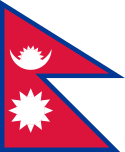Mistrzostwa Azji w Lekkoatletyce 1973
 | |||
| Mistrzostwa Azji w lekkoatletyce Marikina / Manila | |||
| |||
| Miejsce | Rodriguez Sports Center | ||
|---|---|---|---|
| Data | 18 – 23 listopada 1973 | ||
| Liczba konkurencji | 37 | ||
1. Mistrzostwa Azji w Lekkoatletyce – zawody lekkoatletyczne, które odbyły się w Marikinie w pobliżu Manili na Filipinach w 1973 roku. Reprezentanci Japonii wygrali tabelę medalową zdobywając 18 złotych medali. Rywalizacja miała miejsce w dniach 18 - 23 listopada.
Rezultaty
Mężczyźni
| Konkurencja | Wynik | Wynik | Wynik | |||
|---|---|---|---|---|---|---|
| 100 m | Anat Ratanapol | 10.4 | Suchart Chairsuvaparb | 10.5 | Takao Ishizawa | 10.6 |
| 200 m | Anat Ratanapol | 21.0 | Soo Wen-ho | 21.2 | Tokal Mokalam | 21.6 |
| 400 m | Yoshiharu Tomonaga | 46.8 | Koiiro Shika | 47.6 | Ho Mun Cheong | 47.8 |
| 800 m | Muhammad Younis | 1:51.2 | Sri Ram Singh | 1:51.5 | Kazuyoshi Mizuno | 1:52.2 |
| 1500 m | Kazuyoshi Mizuno | 3:47.4 | Muhammad Younis | 3:48.2 | Dashondha Singh | 3:50.4 |
| 5000 m | Ichio Sato | 14:16.9 | Shivnath Singh | 14:17.0 | Katsuaki Isohata | 14:18.2 |
| 10 000 m | Ichio Sato | 29:54.4 | Shivnath Singh | 29:54.8 | Katsuaki Isohata | 29:55.8 |
| Maraton | Cho Je-hyung | 2:27:31 | Park Chang-yuel | 2:33:45 | Jit Bahadur Chetri | 2:35:38 |
| 3000 m z przeszkodami | Takaharu Koyama | 9:04.0 | Shibib Dagher Al-Lami | 9:10.9 | Mohammad Vojdanzadeh | 9:22.0 |
| 110 m ppł | Shigeo Oki | 14.3 | Ahmad Ishtiaq Mubarak | 14.3 | Marcelo Benauro | 14.4 |
| 400 m ppł | Abdulkadir Guiapar | 52.2 | Talib Faisal Al-Saffar | 52.7 | Tai Shi-yan | 53.1 |
| Skok wzwyż | Teymour Ghiassi | 2.15 | Kazunori Koshikawa | 2.15 | Yon Ismail Park Sang-soo | 2.05 |
| Skok o tyczce | Hisaki Suzuki | 4.36 | Hong Sang-pyo | 4.36 | − | − |
| Skok w dal | Chen Chin-long | 7.82w | Soo Wen-ho | 7.57w | Satish Pillai | 7.53w |
| Trójskok | Mohinder Singh Gill | 15.96w | Cheng Ming-chi | 15.31 | T.C. Yohannan | 14.96 |
| Pchnięcie kulą | Jagraj Singh Mann | 17.00 | Gurdeep Singh | 16.37 | Bahadur Singh Chouhan | 15.75 |
| Rzut dyskiem | Jalal Keshmiri | 51.20 | Praveen Kumar | 49.08 | Toji Hayashi | 48.04 |
| Rzut młotem | Ajmer Singh | 60.42 | Jeung Sub-kil | 49.20 | Oumvan Narith | 41.24 |
| Rzut oszczepem | Allah Dad | 63.58 | Nashatar Singh Sidhu | 63.28 | Gopal Kidyoor | 58.28 |
| Dziesięciobój | Vijay Singh Chauhan | 7245 pkt. | Junichi Onizuka | 7076 pkt. | Chen Chin-long | 6752 pkt. |
| Chód na 20 km[1] | Yoshio Morikawa | 1:11:31 | Francis Xavier | ? | Khoo Chong Beng | ? |
| Sztafeta 4 x 100 m | 40.0 | 40.0 | 40.3 | |||
| Sztafeta 4 x 400 m | 3:10.2 | 3:12.8 | 3:13.2 |
Kobiety
| Konkurencja | Wynik | Wynik | Wynik | |||
|---|---|---|---|---|---|---|
| 100 m | Amelita Alanes | 11.6w | Michiko Morita | 12.0w | Sayo Yamato | 12.0w |
| 200 m | Michiko Morita | 24.7 | Amelita Alanes | 25.0 | Satomi Fukuda | 25.2 |
| 400 m | Nobuko Kawano | 55.2 | Keiko Ikoma | 56.1 | Maimoon Azlan | 56.1 |
| 800 m | Nobuko Kawano | 2:08.1 | Chee Swee Lee | 2:08.1 | Harumi Fugimoto | 2:09.6 |
| 1500 m | Miyako Inoue | 4:26.8 | Lee Chiu-hsia | 4:28.0 | Rachel Halle | 4:34.6 |
| 100 m ppł | Tomomi Hayashida | 13.6w | Lin Yet-hsiang | 13.9w | Gan Bee Wah | 14.2w |
| 200 m ppł | Tomomi Hayashida | 27.6w | Heather Merican | 28.5w | Lin Yet-hsiang | 28.6w |
| Skok wzwyż | Orit Abramowicz | 1.68 | Gladys Chai Ng Mei | 1.58 | Maryam Sedarati | 1.58 |
| Skok w dal | Kumi Kawada | 6.07 | Lin Yet-hsiang | 5.84 | Li Hua-wa | 5.71 |
| Pchnięcie kulą | Paik Ok-ja | 15.05 | Kayoko Hayashi | 13.63 | Chen Fu-mei | 12.93 |
| Rzut dyskiem | Josephine de la Viña | 50.74 | Kayoko Hayashi | 45.28 | Paik Ok-ja | 44.52 |
| Rzut oszczepem | Mieko Takasaka | 49.74 | Erlinda Lavandia | 45.38 | Proch Thin | 43.48 |
| Pięciobój lekkoatletyczny | Lin Chun-yu | 4025 pkt. | Kumi Kawada | 3963 pkt. | Li Hua-wa | 3578 pkt. |
| Sztafeta 4 x 100 m | 46.7 | 47.0 | 47.7 | |||
| Sztafeta 4 x 400 m | 3:48.9 | 3:50.1 | 3:57.8 |
Tabela medalowa
| Pozycja | Państwo | ||||
|---|---|---|---|---|---|
| 1 | 18 | 8 | 8 | 34 | |
| 2 | 4 | 5 | 6 | 15 | |
| 3 | 4 | 3 | 3 | 10 | |
| 4 | 2 | 6 | 7 | 15 | |
| 5 | 2 | 3 | 2 | 7 | |
| 6 | 2 | 2 | 0 | 4 | |
| 7 | 2 | 1 | 0 | 3 | |
| 8 | 2 | 0 | 2 | 4 | |
| 9 | 1 | 0 | 1 | 2 | |
| 10 | 0 | 4 | 4 | 8 | |
| 11 | 0 | 3 | 1 | 4 | |
| 12 | 0 | 2 | 0 | 2 | |
| 13 | 0 | 0 | 2 | 2 | |
| 14 | 0 | 0 | 1 | 1 |
Przypisy
- ↑ Skrócona trasa chodu.
Bibliografia
- Asian Championships, GBRathletics [dostęp 2010-08-24] (ang.).
Media użyte na tej stronie
Pictograms of Olympic sports – . This is an unofficial sample picture. Images of official Olympic pictograms for 1948 Summer Olympics and all Summer Olympics since 1964 can be found in corresponding Official Reports.
Autor: https://phabricator.wikimedia.org/diffusion/GOJU/browse/master/AUTHORS.txt, Licencja: MIT
An icon from the OOjs UI MediaWiki lib.
Autor: https://phabricator.wikimedia.org/diffusion/GOJU/browse/master/AUTHORS.txt, Licencja: MIT
An icon from the OOjs UI MediaWiki lib.
The national flag of Kingdom of Thailand since September 2017; there are total of 3 colours:
- Red represents the blood spilt to protect Thailand’s independence and often more simply described as representing the nation.
- White represents the religion of Buddhism, the predominant religion of the nation
- Blue represents the monarchy of the nation, which is recognised as the centre of Thai hearts.
The Flag of India. The colours are saffron, white and green. The navy blue wheel in the center of the flag has a diameter approximately the width of the white band and is called Ashoka's Dharma Chakra, with 24 spokes (after Ashoka, the Great). Each spoke depicts one hour of the day, portraying the prevalence of righteousness all 24 hours of it.
New Version of ا:Image:Lionflag.svg with a cleaner emblem and the correct ratio.
Flag of Israel. Shows a Magen David (“Shield of David”) between two stripes. The Shield of David is a traditional Jewish symbol. The stripes symbolize a Jewish prayer shawl (tallit).
Autor: FilRB / Maix, Licencja: CC BY 3.0
A gold/silver/bronze medals icon for Asian Games
Flag of Iraq, 1963-1991. Also flag of Syria, 1963-1972.


















